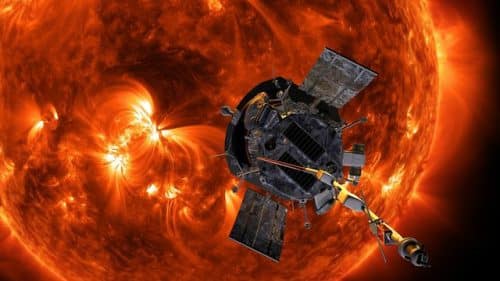The spacecraft is protected by a heat shield on the side facing the sun that will allow it to maintain a temperature of 30 degrees Celsius in a very hot environment

This morning (10:31 Israel time) NASA's Parker space probe was launched from Cape Canaveral to study the Sun.
The spacecraft, which is supposed to approach to a distance of about 6 million km from the sun, was launched on top of a heavy Delta 4 rocket. It will reach orbit around the sun in December.
The spacecraft's orbit brings it closer to the Sun than any spacecraft to date, and it will also be the fastest spacecraft, even faster than New Horizons.
Parker is planned to explore the Sun's outer atmosphere - the corona and reveal new insights about the mechanism of the Sun's operation, and especially the variety of energy and heat particles that cross the corona and fly ionized particles into the solar system, even as far as Neptune/Rahab, the farthest planet from the Sun.
Inside the corona, the heat reaches hundreds of thousands of degrees and more, due to the fact that it is bombarded with particles and radiation from the sun.
So how will she not melt?
The Parker solar spacecraft was designed to withstand extreme conditions and strong temperature fluctuations. The key to its survival lies in its customized heat shield, which contains an autonomous system that helps protect the spacecraft from strong light emissions from the sun, but allows material from the corona to "touch" the spacecraft.
One of the clues to understanding what protects the spacecraft from the high heat is the understanding of the concept of heat versus temperature. Contrary to intuition, high temperatures do not translate into heating of an object.
Temperatures of thousands of degrees can be measured in space without significant heating to the spacecraft that felt it. The reason for this - the temperature actually measures how fast the particles move, while heat measurement measures the amount of energy they transfer. Particles can move fast (high temperature) but if there are only a few of them, they will not transfer much energy to the spacecraft (little warming). Since space is mostly empty, there are very few particles that can transfer energy to space.

The corona through which the Parker spacecraft will pass, for example, has high temperatures, but low density. Think about the difference between putting your hand in the oven versus putting it in a glass of boiling water (don't try this at home). In the oven, the hand can withstand significantly higher temperatures for a longer time than in water because the water next to it has many contact points with many more particles. Therefore the spacecraft will encounter fewer hot particles, so it will not absorb as much heat.
This means that the Parker spacecraft will travel in space where temperatures reach several million degrees, the surface of its heat shield will come close to the Sun but will only feel 1,400 degrees Celsius.
Of course, these are high enough temperatures. For comparison, lava erupts from volcanoes in the range of 1,200-700 degrees. To withstand the heat, Parker uses a Thermal Protection System, or TPS heat shield that is 2.4 meters in diameter and about 115 mm (11.5 cm) thick. These few centimeters of protection mean that on the other side of the heat shield, the body of the spacecraft will feel an average temperature of 30 degrees Celsius.
The TPS was designed at Johns Hopkins University's Applied Physics Laboratory, and was built using reinforced carbon, using composite carbon foam slices between two carbon plates. The final structure is coated with ceramic paint on a plate facing the sun, to return as much heat as possible. The TPS was tested at temperatures of about 1,650 degrees. It can now survive any heat the sun can throw at it, and will keep almost all devices in a safe temperature range.
Background material on the NASA website
More on the subject on the science website
